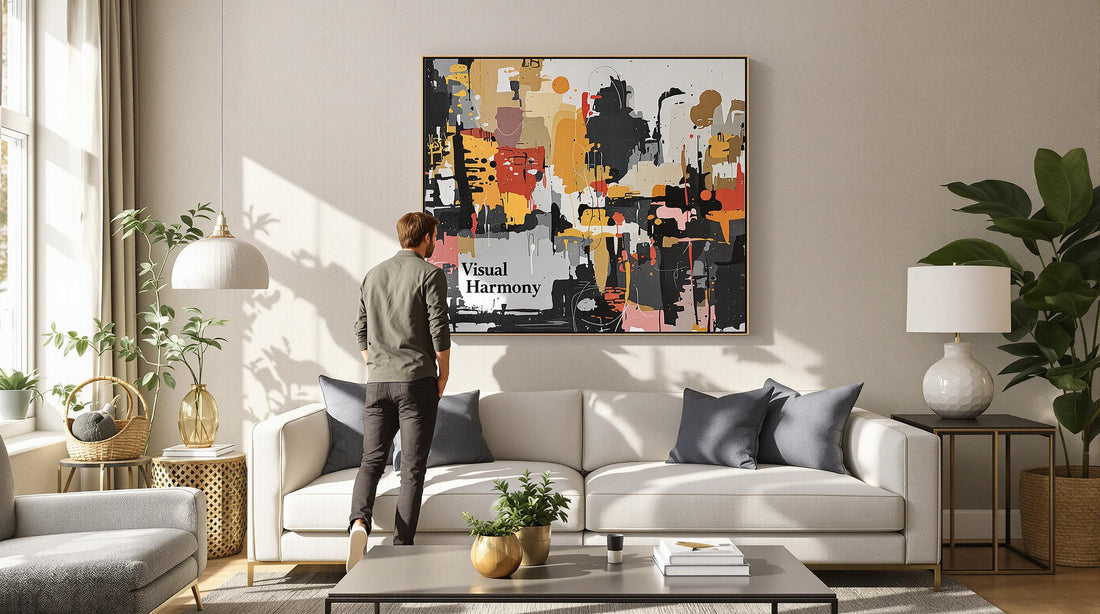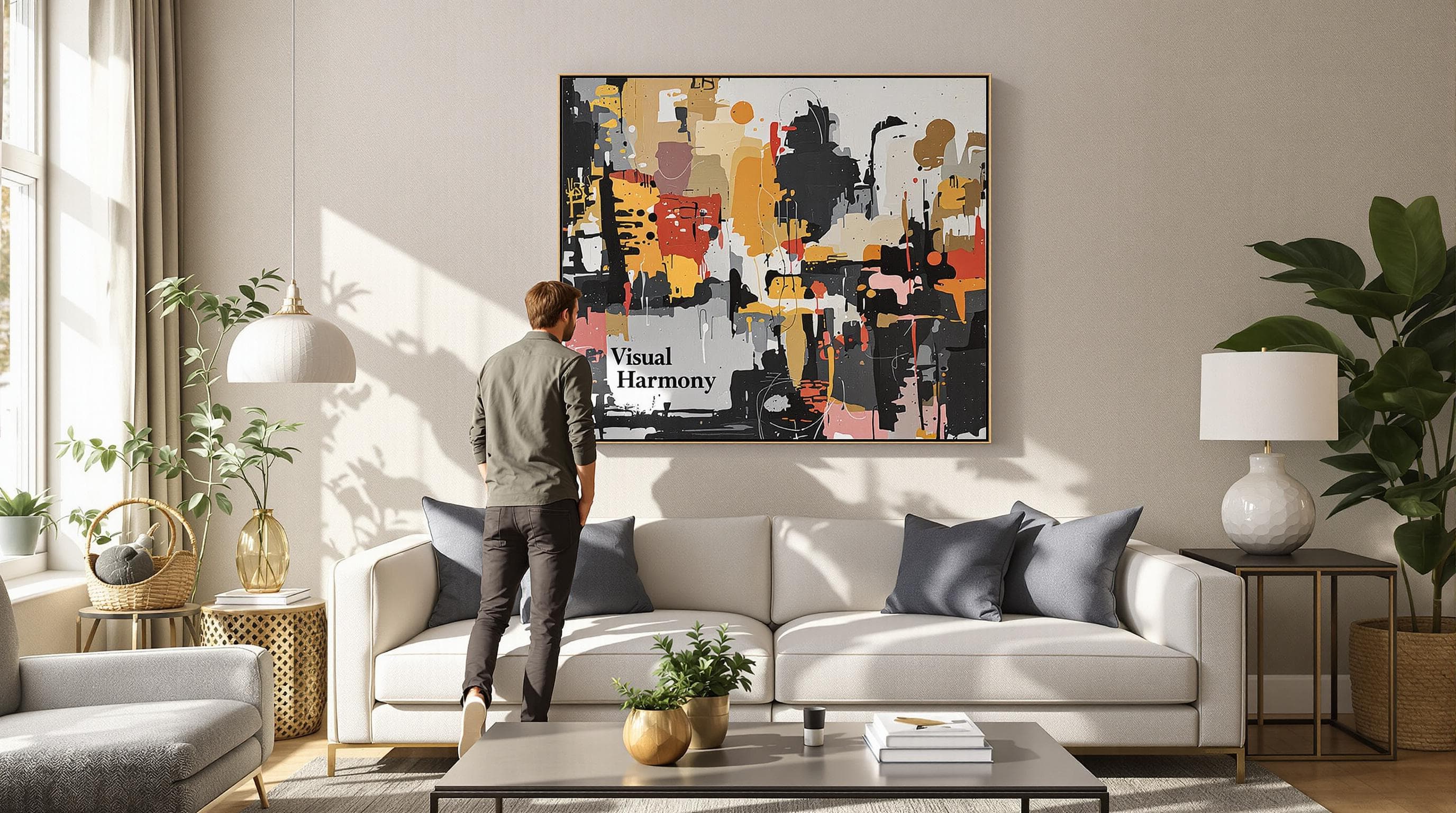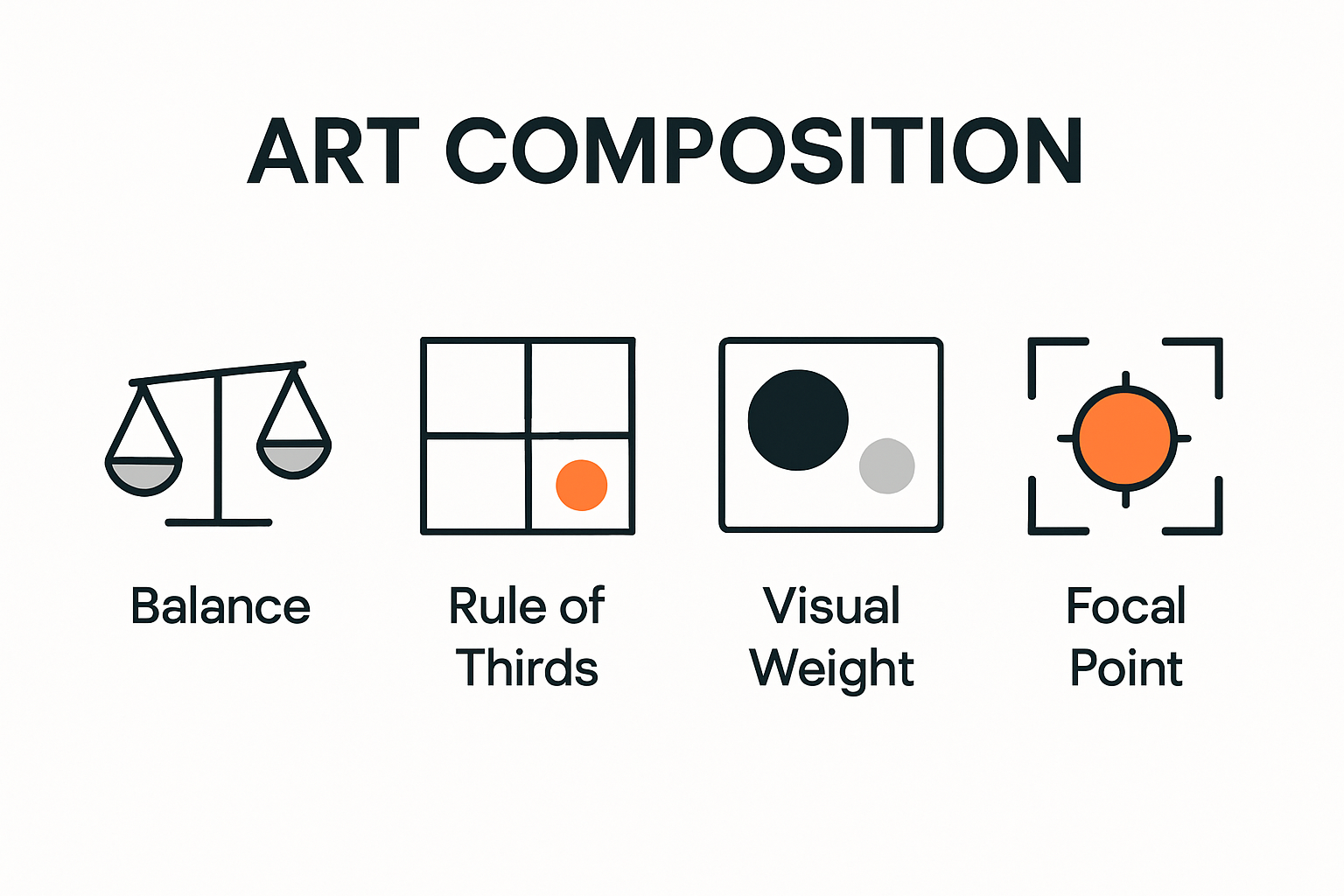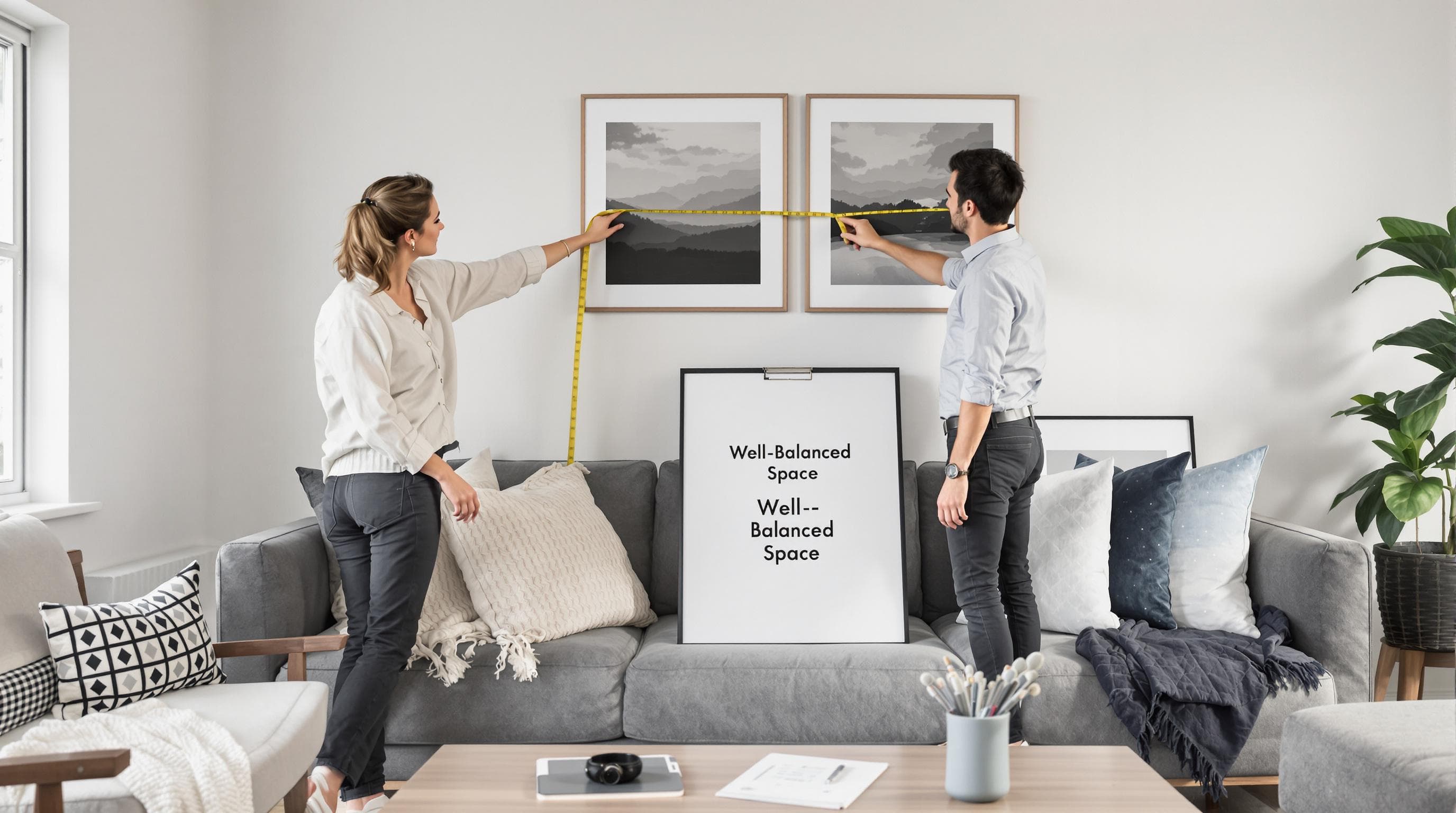
Understanding Art Composition: A 2025 Guide for Collectors and Decorators

Art composition is at the heart of every striking painting and curated space. Collectors and decorators might focus on color or subject, but here’s something most overlook. Art that fills between 65% and 85% of your furniture’s width creates the strongest visual harmony and emotional pull. That secret is what transforms random pieces into a story worth telling.
Table of Contents
- What Is Art Composition And Why It Matters
- Key Principles Shaping Modern And Abstract Art
- How To Evaluate Wall Art For Your Space
- Choosing Art That Reflects Your Personal Style
Quick Summary
| Takeaway | Explanation |
|---|---|
| Understand art composition’s role | Art composition is essential for storytelling and emotional connection in artwork. |
| Recognize compositional techniques | Techniques like the rule of thirds and symmetry enhance viewer engagement and perception. |
| Evaluate art dimensions thoughtfully | Art should occupy 65-85% of furniture width for optimal visual balance in a room. |
| Choose art reflecting personal style | Artwork should resonate emotionally and thematically with your personal narrative and identity. |
| Art collections are personal journeys | Curating art is about expressing your life story and evolving experiences through visual media. |
What Is Art Composition and Why It Matters
Art composition is the strategic arrangement of visual elements that transforms a simple collection of colors, shapes, and lines into a compelling narrative. Understanding art composition goes beyond aesthetic appreciation—it is the fundamental language through which artists communicate emotion, meaning, and perspective.

The Essential Framework of Visual Storytelling
At its core, art composition is about creating balance, directing viewer attention, and generating visual harmony. The Getty Center explains that composition refers to how artists deliberately organize elements within their work to create specific visual experiences. This deliberate arrangement determines how viewers perceive and emotionally connect with an artwork.
Key compositional elements include:
- Spatial Relationships: How objects and spaces interact within the artwork
- Visual Weight: The perceived importance of different elements
- Balance: The distribution of visual elements to create stability or intentional tension
To help clarify the main compositional elements discussed above, here’s a summary table:
| Element | Definition | Role in Composition |
|---|---|---|
| Spatial Relationships | Interaction of objects and spaces within artwork | Establishes depth and arrangement |
| Visual Weight | Perceived importance of different elements | Directs viewer focus |
| Balance | Distribution of visual elements for stability or intentional tension | Creates harmony or dynamic interest |
Breaking Down Compositional Techniques
Research from ERIC highlights that understanding composition is crucial for developing visual literacy. Professional artists and designers employ multiple techniques to guide viewer perception. These might include the rule of thirds, leading lines, symmetry, or asymmetrical balance.
For art collectors and decorators, comprehending composition means seeing beyond surface aesthetics. It involves recognizing how an artwork’s internal structure communicates its underlying message. A well-composed piece doesn’t just depict something—it tells a story, evokes emotion, and creates a powerful visual dialogue.
Why Composition Matters for Collectors and Decorators
For those selecting art for personal or professional spaces, understanding composition becomes a critical skill. A thoughtfully composed artwork can transform a room’s atmosphere, create focal points, and reflect personal aesthetic sensibilities. Whether you are choosing a large statement piece or curating a gallery wall, recognizing compositional principles allows you to make more informed and meaningful selections.
The power of art composition lies in its ability to transcend mere visual representation. It is a complex language of visual communication that invites viewers to engage more deeply with the artwork, discovering layers of meaning and emotional resonance in each carefully arranged element.
Key Principles Shaping Modern and Abstract Art
Modern and abstract art represent a radical departure from traditional representational techniques, challenging viewers to engage with visual language in unprecedented ways. These art forms prioritize emotional expression, conceptual meaning, and compositional innovation over literal depiction.
Deconstruction of Visual Representation
The College Art Association’s Art Journal highlights how modern artists deliberately dismantle conventional visual expectations. Composition in modern and abstract art becomes a deliberate strategy of breaking down recognizable forms into fundamental elements of color, shape, line, and spatial relationships.
Key principles that define these artistic approaches include:
- Emotional Abstraction: Prioritizing feeling over literal representation
- Geometric Transformation: Reducing forms to essential geometric structures
- Dynamic Spatial Relationships: Creating tension and movement through compositional arrangements
The Language of Non Representational Art
Abstract art composition functions as a complex visual communication system. Artists use strategic placement, color interactions, and structural dynamics to convey meaning without relying on recognizable imagery. This approach invites viewers to interpret artwork through personal emotional and intellectual experiences.
For those interested in exploring these artistic concepts further, our guide on contemporary art trends provides deeper insights into how modern compositional techniques continue to evolve.
Compositional Strategies in Modern Art
Modern artists employ sophisticated compositional techniques that challenge traditional perceptions. These strategies might include deliberate asymmetry, fragmented perspectives, overlapping planes, and unexpected color relationships. Such approaches transform composition from a mere organizational tool into a powerful medium of artistic expression.
Understanding these principles allows art collectors and decorators to appreciate the nuanced complexity of modern and abstract artworks. Each piece becomes more than a visual object—it is a carefully constructed language of emotion, concept, and visual experience that invites continuous reinterpretation and engagement.
How to Evaluate Wall Art for Your Space
Selecting the perfect wall art requires more than aesthetic appreciation—it demands a strategic approach that considers spatial dynamics, personal style, and compositional harmony. Understanding how to evaluate artwork transforms the process from mere decoration to intentional design.
Proportions and Scale: The Foundation of Art Placement

Artspace recommends that artwork should occupy between 65% and 85% of the furniture’s width to maintain visual balance. This principle ensures that your art piece feels integrated with the surrounding environment rather than appearing disconnected or overwhelming.
Key considerations for proportional art selection include:
- Width Alignment: Matching artwork width to furniture dimensions
- Wall Coverage: Occupying approximately 60–75% of available wall space
- Visual Weight: Balancing the artwork’s visual impact with room elements
The following table summarizes key guidelines for evaluating wall art proportions and placement:
| Guideline | Recommended Range / Approach | Purpose |
|---|---|---|
| Artwork to Furniture Width | 65% – 85% of furniture width | Achieve visual balance with furniture |
| Artwork to Wall Coverage | 60% – 75% of available wall space | Ensure integrated, impactful presence |
| Visual Weight Balance | Consider room’s visual elements | Prevent artwork from overwhelming space |
Compositional Harmony and Room Dynamics
Moving.com’s interior design guide emphasizes that successful art integration goes beyond mere measurement. Each artwork should complement the room’s existing color palette, architectural features, and overall mood.
For those seeking deeper insights into creating cohesive wall designs, our guide to living room art selection offers comprehensive strategies for transforming spaces.
Personal Style and Emotional Resonance
Beyond technical considerations, European Art Association highlights the importance of emotional connection. An ideal artwork should not only fit spatially but also reflect your personal narrative and evoke meaningful emotional responses.
When evaluating wall art, consider these nuanced factors:
- How does the artwork make you feel?
- Does it complement or intentionally contrast with your existing decor?
- Will it create a focal point or blend harmoniously with the room?
Ultimately, selecting wall art is an intimate process of creating visual narratives within your personal spaces. By understanding compositional principles and spatial dynamics, you transform walls from mere structural elements into powerful expressions of personal style and artistic appreciation.
Choosing Art That Reflects Your Personal Style
Personal style in art collection is more than aesthetic preference—it is a profound expression of individual identity, emotional landscape, and personal narrative. Selecting artwork becomes an intimate journey of self-discovery and visual storytelling.
Understanding Your Artistic Preferences
Research from ResearchGate emphasizes the importance of self-reflection in developing a unique artistic perspective. This process involves exploring diverse art forms, understanding emotional responses, and recognizing patterns in your aesthetic choices.
Key strategies for identifying personal style include:
- Emotional Resonance: Selecting art that triggers genuine emotional responses
- Thematic Connections: Identifying recurring visual themes that speak to your experiences
- Color and Mood: Recognizing color palettes that align with your personal energy
Exploring Artistic Themes and Techniques
The Art of Education highlights the significance of continuous exploration in developing artistic sensibility. Personal style emerges through active engagement with different art forms, experimenting with various compositions, and understanding what truly resonates with your inner aesthetic.
For those looking to dive deeper into curating a personalized art collection, our guide on art themes provides comprehensive insights into creating meaningful visual narratives.
Curating a Meaningful Art Collection
Building a personal art collection is an evolutionary process that reflects personal growth, experiences, and changing perspectives. It requires courage to move beyond trendy designs and select pieces that genuinely represent your unique journey.
Consider these reflective questions when choosing artwork:
- What stories do these artworks tell about my life?
- How do these pieces make me feel?
- Do they represent my current emotional and aesthetic landscape?
Here’s a checklist table to guide your evaluation when selecting meaningful art for your collection:
| Reflective Question | Considered? (Yes/No) |
|---|---|
| Does the artwork reflect my life story? | |
| Does the piece evoke a genuine emotion? | |
| Does it fit my current aesthetic landscape? | |
| Is it beyond mere decorative purpose? | |
| Does it represent personal growth/changes? |
Ultimately, a truly personal art collection transcends decorative purposes. It becomes a visual autobiography, capturing moments, emotions, and transformative experiences that define your individual narrative. By approaching art selection as a form of self-expression, you create living spaces that are not just aesthetically pleasing but deeply meaningful and authentically yours.
Frequently Asked Questions
What is art composition?
Art composition refers to the strategic arrangement of visual elements in an artwork. It transforms simple colors, shapes, and lines into a compelling narrative, facilitating emotional connections and enhancing viewer engagement.
Why is art composition important for collectors and decorators?
Understanding art composition is crucial for collectors and decorators as it informs their choices. A well-composed artwork can elevate a room’s atmosphere, create focal points, and ensure that the art resonates with personal aesthetic sensibilities.
How can I evaluate the right size of wall art for my space?
Artwork should occupy between 65% and 85% of the furniture’s width for optimal visual balance. Additionally, it should cover approximately 60-75% of the available wall space to create a cohesive and impactful presence.
What principles should I consider when choosing art that reflects my personal style?
Consider emotional resonance, thematic connections, and color preferences. Select art that triggers genuine emotional responses, reflects your life experiences, and aligns with your current aesthetic landscape.
Bring True Art Composition Into Your Home With Curated Canvas Collections
Finding balance and emotional connection in art is a real challenge, especially when you want your décor to both inspire conversation and fit naturally with your space. You’ve just learned how essential art composition is—whether it’s the right proportions on your wall, visual harmony with your furniture, or choosing pieces that tell your personal story. Often, decorators are left searching for artwork that captures both bold presence and subtle unity, and struggle to find collections that simplify this process.
Discover how easy it can be to solve those pain points. Our Art Gallery Opening Night Wall Art – Exclusive Canvas Art is designed for collectors and decorators who want every piece to feel like the centerpiece, yet always balanced and elegant in their space.

Ready to transform your walls into a gallery of intentional beauty? Start browsing our exclusive selections at https://martaellie.com or explore the zen-focused Meditation Retreat Zen Art Collection – Exclusive Canvas Art for rooms seeking calm. Don’t wait—give your home the artful composition it deserves right now.
Recommended
- Art Appreciation Basics: A Guide for Collectors and Decorators 2025 – Exclusive Canvas Art
- Contemporary vs Modern Art: Guide for Collectors & Decorators 2025 – Exclusive Canvas Art
- What Makes Art High Quality: Guide for Collectors & Decorators 2025 – Exclusive Canvas Art
- How to Choose Art Themes: A 2025 Guide for Modern Walls – Exclusive Canvas Art